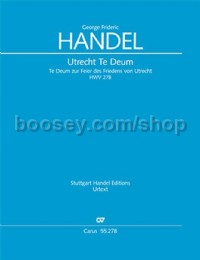Utrecht Te Deum (SSATB)
Utrecht Te Deum (SSATB)
* Estimated price converted from UK retail price
Handel’s Utrecht Te Deum HWV 278 enthralled London audiences right from its first performance, and it continues to do so today in concert halls and churches all over the world. It was performed for the first time in a festive service on 13 July 1713 in St. Paul’s Cathedral to celebrate the Peace marking the end of the twelve year-long War of the Spanish Succession in 1713. The Te Deum was the first commission by the English royal house and was also Handel’s first sacred work in the English language.
For Handel the Utrecht Te Deum was an important milestone at the beginning of his London career. The composition brought him an annual pension from Queen Anne and helped him to establish himself as a composer of prestigious music for the English royal family. Four further settings of the Ambrosian hymn of praise by Handel followed, including the equally popular Dettingen Te Deum (Carus 55.238).
The six soloists required can in practice be reduced to four, and the Te Deum does not contain any stand-alone arias. The chorus is scored in five parts in a few movements (SSATB), with the concluding doxology beginning in double-choir scoring (SST/AATB).




